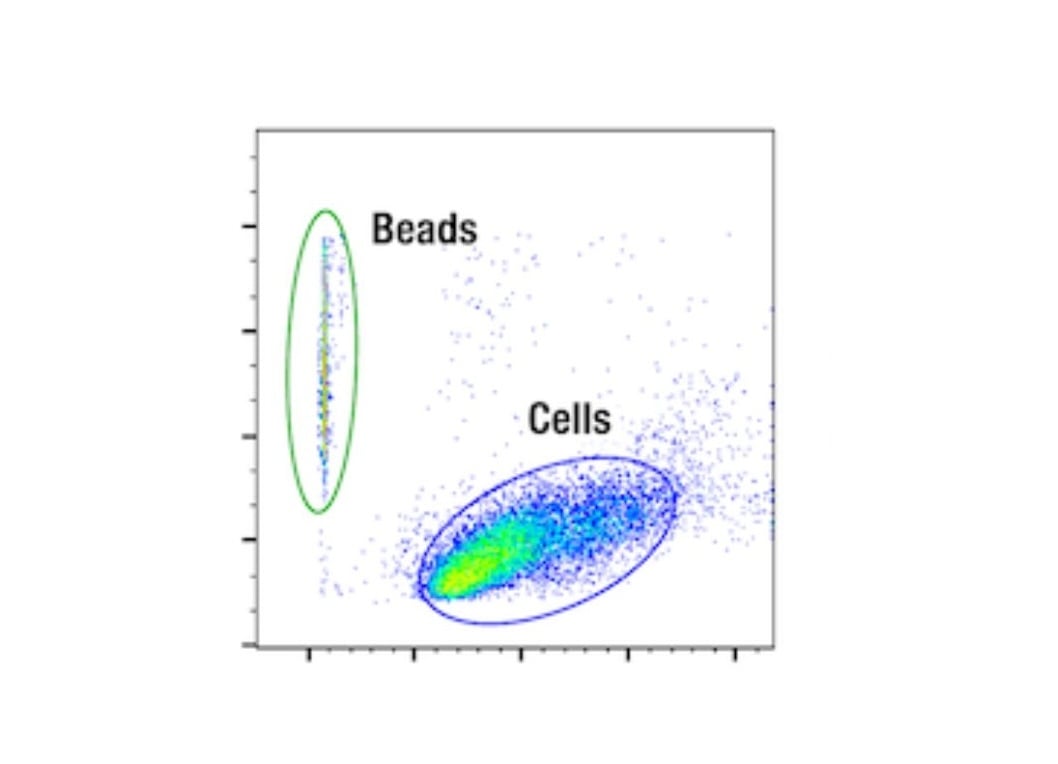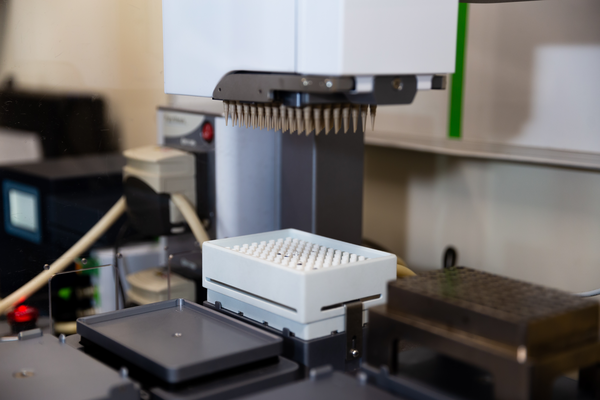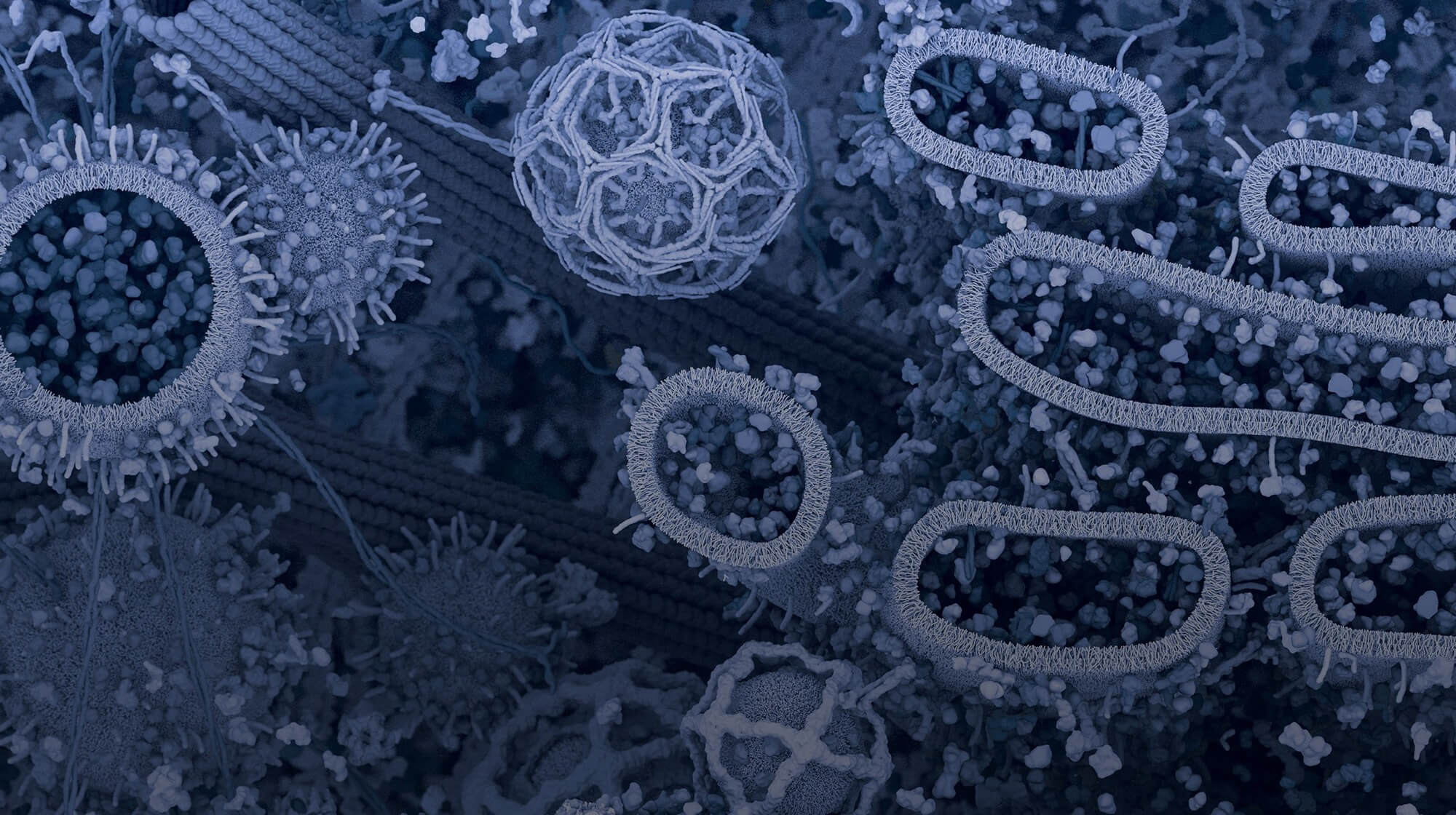研究翻译后修饰 (PTM) 对于加深我们对细胞信号转导、疾病生物学和治疗机制的理解至关重要。CST 的 PTMScan 技术能够在每个样本中定量检测数百到数万个 PTM 位点,是一种强大而多功能的方法,已广泛应用于包括药物发现和表征在内的多个领域,用于识别新型生物标记物。1-4 随着研究人员在药物开发流程中不断扩大样本群规模,将可编程自动化技术整合到 PTMScan 工作流程中,不仅可以提高通量和可重复性,更有助于获得切实可行且可信赖生物学见解的定量数据。
本博客探讨了如何在基于自动化的工作流程中使用 PTMScan 试剂以及其对定量、高通量蛋白质组学研究的好处。
超越 ELISA:利用自动化 LC-MS 进行高通量 PTM 检测
自动化平台常用于类似 ELISA 的检测或高内涵成像应用,在此类应用中,通常一次仅测量少量变量,往往每个样本仅检测一个 PTM 位点。
相比之下,PTMScan 工作流程结合了针对特定 PTM 或 PTM 基序的免疫亲和磁珠的 PTM 富集能力,以及液相色谱-质谱 (LC-MS) 提供的定量测量,从而能够对每个样本中数百到数万个 PTM 位点进行分析,远远超过高内涵成像分析通常能够达到的检测范围

图 1. 使用 PTMScan HS Phospho-Tyrosine (P-Tyr-1000) Kit #38572 生成的数据范围,显示分析深度不断增加。A) 对未经处理 (-) 和经 EGF 配体处理 (+) 的 A431 细胞中整体磷酸酪氨酸 (pY) 水平进行蛋白质印迹分析。B) 统计 PTMScan HS PhosphoTyrosine 从对照和经 EGF 处理样品中鉴定出的独特 pY 位点。C) 从对照和经 EGF 处理样品中鉴定出的独特 pY 位点的重叠情况。D) 定量分析对照和经 EGF 处理的样品中 pY 位点的丰度。
然而,定量蛋白质组学工作流程中长期存在的一个主要瓶颈,是 LC-MS 分析依赖手动操作。随着 MS 技术(例如数据非依赖采集 (DIA) 蛋白质组学)在速度、分辨率和灵敏度方面的不断提升,对长时间采集的依赖有所降低,但富集步骤仍然是一个挑战。基于磁珠的 PTM 富集在手动操作时,不仅耗费大量时间,还可能导致样本间结果不一致。自动化在此工作流程中的应用,体现出其最显著的优势。
为验证 PTMScan 试剂在高通量亲和富集流程中的平台兼容性,并评估其对实验可重复性的影响,我们在几种最常用的商业平台(见表 1)上进行了测试。
表 1:定量蛋白质组学的自动化平台
| 平台 | 兼容产品 |
| 磁珠处理器平台(例如 ThermoFisher 的 KingFisher 系列)仅通过在孔板间移动磁珠来完成操作。5-7 | PTMScan HS 试剂盒 |
| 混合平台(如 Agilent 的 AssayMap Bravo 系列)采用预装富集抗体试剂的定制化吸头,通过吸头在孔板间转移液体来实现操作。1 | 不含磁珠的定制 PTMScan 试剂配方。了解有关 CST 定制试剂的更多信息。 |
| 液体处理平台,例如 Hamilton、Tecan、Beckman Coulter、Revvity 等公司的系统。 | PTMScan HS 试剂盒 |
在我们的测试中,自动化操作在各方面均明显优于手动工作流程——例如,使用 AssayMAP Bravo 系统进行样本制备时,肽鉴定数量相比手动方法提升了 30% 至 135%。此外,针对基于磁珠的 PTMScan HS 试剂,KingFisher Apex 平台实现的自动化富集在数据质量上与手动操作流程一致,但用户操作更为简便,且具备更好的可扩展性,适用于处理大批量样本。
请继续阅读,了解我们在不同平台类型上的研究结果详情,并参阅文献中作者们利用 PTMScan 试剂进行自动化工作流程的示例参考。
磁珠处理器平台
可以说,磁珠处理器类型的平台最方便用户使用。由于 PTMScan HS 试剂中使用的磁珠相对较大,能够被磁性探针快速捕获和转移,因此该平台非常适合磁珠处理自动化机器人。
为了测试性能,我们使用 PTMScan HS Ubiquitin/SUMO Remnant Motif (K-ε-GG) Kit #59322 和 ThermoFisher KingFisher Apex 系统比较了手动和自动泛素富集实验。我们发现自动化实验与手动操作在 PTM 肽回收效果上无显著差异。
|
|
作者信息:虽然肽和缓冲液可以用多通道移液器或其他类型的液体分配器来分装,但在移液过程中手动分装磁珠并在每一步充分混匀,能够在各孔之间获得更一致且更具重复性的等分样本。 |
|
在 KingFisher Apex 上使用 PTMScan HS 试剂盒
- 方法与实验设置:在典型的实验流程中,磁珠、肽样品和洗涤/洗脱缓冲液被分装到孔板中,每个孔对应一个样本与富集组合。我们使用内部开发的 KingFisher Apex 实验步骤,使用 PTMScan HS Ubiquitin/SUMO Remnant Motif (K-ε-GG) #59322 分别在两个不同日期进行了泛素富集实验。每个日期均执行一次手动富集和一次基于 KingFisher 的自动化富集,且均包含三个生物学重复(即三组并行富集),所有实验均使用相同类型的输入肽样本(小鼠肝脏肽)。
- 结果:我们发现自动化实验与手动操作在 PTM 肽回收效果上无显著差异。

图 2. 对比分析了 PTMScan HS 泛素实验中,手动富集与 KingFisher Apex 机器人自动富集所产生数据的可重复性。A) 已鉴定的独特 PTM 肽的数量。B) 手动流程与 KingFisher 流程中约 1000 个随机选择的 PTM 肽的重叠情况。C) 手动流程与 KingFisher 流程共有 PTM 肽的 MS1 峰面积(自然对数转换)无标记定量分析。
您还可以浏览以下论文,其中研究人员在高通量工作流程中使用了 PTMScan 试剂:
自动化 UbiFast 以实现高通量和多重泛素富集
|
|
用于全面乙酰基组分析的自动化免疫沉淀工作流程
|
|
雄激素通过诱导致瘤岩藻糖基化来驱动黑色素瘤的侵袭和转移性扩散
|
|
|
用于从复杂混合物中捕获 KGG 修饰肽的自动 PTMScan 免疫亲和富集
|
混合平台
PTMScan 试剂盒还与 Agilent AssayMAP Bravo 系统等混合自动化系统兼容。与磁珠处理系统不同,该平台使用专门的吸头(通常预装蛋白质 A),可以将 PTMScan 试剂盒中的抗体固定在这些吸头上。在这种混合平台中,液体处理器不是将基于 PTMScan 珠子的浆液与肽溶液或洗涤缓冲液一起孵育,而是通过装有抗体的吸头抽吸液体完成反应。
这种方法为一系列经 PTMScan 验证的抗体(包括未与磁珠结合的抗体)提供了更大的实验灵活性和更广泛的兼容性。虽然基于磁珠的 PTMScan HS 产品不适用于混合平台,但经 PTMScan 验证的非磁珠结合抗体则非常适合用于这一高度可重复且操作简便的平台。
 Alissa Nelson Alissa Nelson蛋白质组部门首席科学家 |
作者信息: 此类平台在操作过程中容易出现吸头堵塞的问题。为最大限度降低该风险,建议用户在进行 PTM 富集前,先对肽样品进行水浴超声处理,并以 10,000xg 的速度离心 5 分钟,以去除不溶性颗粒物。 |
|
为评估 PTMScan 试剂在 AssayMAP Bravo 平台上的表现,我们比较了三种不同抗体靶标在手动琼脂糖珠富集与吸头富集方式下的效果。结果表明,AssayMAP Bravo 平台上的双向抽吸程序可获得最佳效果,包括显著高于手动制备的肽鉴定数量。
在 Agilent AssayMAP Bravo 系统上使用 PTMScan 试剂
方法与实验设置:我们将三种研究较为充分的 PTM 在手动琼脂糖珠富集与吸头富集两种方式下进行了对比:使用 PTMScan Acetyl-Lysine Motif [Ac-K] Kit #13416 检测乙酰赖氨酸;使用 PTMScan Ubiquitin Remnant Motif (K-ε-GG) Kit #5562 检测泛素,以及使用 PTMScan Phospho-Tyrosine Rabbit mAb (P-Tyr-1000) Kit #8803 检测磷酸酪氨酸。
免疫沉淀 (IP) 在两天内进行,并在 Thermo Scientific Q-Exactive 系统上采集 LC-MS 样品。Agilent AssayMAP Bravo 软件为抗体纯化提供了两种通用工作流程:
- 双向抽吸程序,其中肽通过吸头底部被吸入,然后分配至流通式收集板。
- 单向抽吸程序(仅分液)样品先由裸探针吸头吸入,再从吸头顶部分配出肽。
结果:我们发现双向抽吸程序的表现明显优于手动制备和单向分液程序——与手动制备相比,双向抽吸程序在 PTM 肽鉴定数量方面提升了 30-135%,而单向分液程序的表现甚至低于手动操作。

图 3. 此示例展示了在多种 PTMScan 实验中,使用手动方法或 AssayMAP Bravo 机器人进行富集时所得数据的一致性与可重复性。请注意,当通过自动化平台执行工作流程时,PTM 肽的回收率有所提高。
|
需要定制 PTMScan 产品?点击此处查询批次预订、订购批量试剂和定制试剂制剂,或联系您的 CST 客户经理。 |
|
您还可以阅读以下论文,其中研究人员在高通量工作流程中使用了 PTMScan 试剂:
MRTX1719 是一种 MTA 协同 PRMT5 抑制剂,在临床前模型和 MTAP 缺失癌症患者中表现出合成致死性
|
液体处理器平台
PTMScan HS 试剂盒与自动化液体器处理平台兼容。兼容的系统包括 Beckman Coulter 的 Biomek i 系列自动液体处理工作站和 Hamilton 的 Microlab 自动液体处理器系列。
自动化液体处理平台通常通过一系列步骤操作:首先将溶液从公共试剂槽转移至含有 PTMScan HS 磁珠试剂的各个孔中;随后通过抽吸实现混合;接着将整个孔板置于磁性模块上,使磁珠聚集至孔的侧壁或底部;最后进行溶液的更换或收集。
突破瓶颈:选择正确的蛋白质组学自动化战略
CST 的 PTMScan 试剂盒为多种机器人平台上的 PTM 富集自动化提供了灵活高效的解决方案。无论是采用基于磁珠的 PTMScan HS 试剂盒配合高通量磁珠处理系统,还是使用 PTMScan“经典”抗体制剂结合 AssayMAP Bravo 等混合平台,研究人员均能在定量蛋白质组学研究中实现更高的可重复性、分析深度及扩展能力。
其他资源
- 要了解有关评估蛋白质组学实验的可重复性的更多信息,请阅读有关如何使用 PTMScan 添加合成对照肽的博客。
- 网络讲座:对早期药物发现中的翻译后修饰进行蛋白质组学分析 | 演讲嘉宾:Don Kirkpatrick 博士,K48 Consulting;Lilian Phu,Greentech;以及 Matt Stokes 博士,CST
Cell Signaling Technology 蛋白质组学组首席科学家 Alissa Nelson 博士也为撰写这篇博文做出了贡献。
参考文献
- Engstrom LD, Aranda R, Waters L, et al. MRTX1719 Is an MTA-Cooperative PRMT5 Inhibitor That Exhibits Synthetic Lethality in Preclinical Models and Patients with MTAP-Deleted Cancer. Cancer Discov. 2023;13(11):2412-2431. doi:10.1158/2159-8290.CD-23-0669
- Montoya S, Bourcier J, Noviski M, et al. Kinase-impaired BTK mutations are susceptible to clinical-stage BTK and IKZF1/3 degrader NX-2127. Science. 2024;383(6682):eadi5798. doi:10.1126/science.adi5798
- Crowe C, Nakasone MA, Chandler S, et al. Mechanism of degrader-targeted protein ubiquitinability. Sci Adv. 2024;10(41):eado6492. doi:10.1126/sciadv.ado6492
- Safa-Tahar-Henni S, Páez Martinez K, Gress V, et al. Comparative small molecule screening of primary human acute leukemias, engineered human leukemia and leukemia cell lines. Leukemia. 2025;39(1):29-41. doi:10.1038/s41375-024-02400-w
- Rivera KD, Olive ME, Bergstrom EJ, et al. Automating UbiFast for High-throughput and Multiplexed Ubiquitin Enrichment. Mol Cell Proteomics. 2021;20:100154. doi:10.1016/j.mcpro.2021.100154
- Gritsenko MA, Tsai CF, Kim H, Liu T. Automated Immunoprecipitation Workflow for Comprehensive Acetylome Analysis. Methods Mol Biol。2024;2823:173-191. doi:10.1007/978-1-0716-3922-1_12
- Liu Q, Adhikari E, Lester DK, et al. Androgen drives melanoma invasiveness and metastatic spread by inducing tumorigenic fucosylation. Nat Commun. 2024;15(1):1148. Published 2024 Feb 7. doi:10.1038/s41467-024-45324-w
25-TPD-92200








 沪公网安备31011502018823号
沪公网安备31011502018823号